Meet Sarah, a lively and independent 70-year-old woman who loves to explore unknown places and enjoys an active lifestyle. Recently, however, Sarah experienced a frightening fall that left her with a fractured hip. The incident caused her physical pain and diminished her confidence and sense of security.
Determined to regain her independence, Sarah embarked on a journey to learn how to prevent falls and fractures in older adults. She discovered falls are not inevitable in aging, and we can prevent them with a few simple strategies.
Sarah learned the importance of maintaining a physically active lifestyle. Regular exercise, including strength and balance training, helps to strengthen muscles and improve stability. She incorporated activities like walking, yoga, and even dancing, which enhanced her fitness and brought joy to her life.
In her quest for fall prevention, Sarah recognized the need for a safe home environment. She made a few adjustments, such as removing trip hazards like loose rugs and clutter, installing grab bars near the tub and toilet, and ensuring adequate lighting throughout her living space.
Sarah also realized the significance of regular health check-ups. By working closely with her healthcare provider, she received guidance on managing medications, treating underlying health conditions, and addressing vision and hearing changes that could contribute to falls.
Furthermore, Sarah joined a local community group focused on fall prevention for older adults. Through this group, she gained valuable insights, attended workshops on fall prevention techniques, and formed supportive friendships with individuals who shared her goals.
By implementing these prevention strategies, Sarah noticed remarkable improvements. Her confidence soared as she regained her balance and strength. She could once again enjoy her favorite activities with a renewed sense of security.
Inspired by her journey, Sarah is committed to spreading awareness about fall prevention among older adults. She believes that by adopting these strategies and making small changes in their lives, older adults can dramatically reduce the risk of falls and fractures and bask in the joy of healthy aging.
Falls and fractures are a significant health concern among older adults. Our bones become more fragile as we age, and our balance may deteriorate, making us more susceptible to falls and subsequent fractures. According to the Centers for Disease Control and Prevention (CDC), over 14 million adults aged 65 and older, approximately one in four, report falling each year in the United States. While not all falls result in injuries, about 37% of those who fall report an injury that requires medical treatment or restricts their activity for at least one day. This amounts to about nine million fall-related injuries in older adults annually.
Understanding the Risk Factors:
It’s essential to understand the risk factors associated with falls and fractures in older adults:
1. Age: Our bones lose density and strength as we age, making them more prone to fractures. Decreased muscle mass and slower reflexes can also contribute to falls.
2. Gender: Women, especially after menopause, have a higher risk of fractures due to decreased bone density.
3. Medical Conditions: Chronic conditions like osteoporosis, arthritis, and diabetes may affect balance and bone health. Osteoporosis, in particular, results in weaker bones susceptible to fractures.
4. Medications: Some medications can cause dizziness or drowsiness, increasing the risk of falls. Consult your healthcare provider to understand the potential side effects of your drugs.
5. Environmental Factors: Slippery floors, poor lighting, and cluttered living spaces contribute to falls. Identifying and addressing these hazards at home is crucial.
Prevention Strategies:
Now, let’s explore each prevention strategy in depth:
1. Stay Physically Active: Regular exercise improves strength, balance, and flexibility. Activities like walking, Tai Chi, and strength training help reduce the risk of falling. Consult a healthcare provider before starting an exercise program tailored to your needs.
2. Medication Management: Keep a comprehensive list of all medications, including over-the-counter drugs and supplements. Review this list with your healthcare provider to identify potential balance or coordination side effects.
3. Vision Care: Regular eye check-ups are essential, as vision changes can lead to falls. Corrective lenses can improve vision and reduce the risk of trips and falls.
4. Home Safety: Make your home safer by removing tripping hazards such as rugs, clutter, and loose cords. Install handrails in stairwells and grab bars in the bathroom for additional support. Adequate lighting is crucial for visibility and reducing the risk of falls.
5. Foot Care: Choose well-fitting, supportive shoes with non-slip soles to improve stability. Avoid walking in socks or slippers on slippery surfaces.
6. Nutrition and Bone Health: Consume a diet rich in calcium and vitamin D to maintain strong bones. Dairy products, leafy greens, and supplements can help. Adequate calcium and vitamin D intake are essential for maintaining bone density.
7. Regular Check-ups: Visit your healthcare provider regularly to monitor your overall health, including bone density and balance. They can assess your risk factors and guide you in managing chronic conditions that may affect your risk of falls and fractures.
8. Fall-Prevention Aids: Consider using assistive devices such as walking canes or walkers to improve stability and provide confidence when moving around.
9. Stay Hydrated: Dehydration can lead to dizziness and weak muscles, increasing the risk of falls. Drink plenty of water throughout the day to maintain proper hydration levels.
10. Fall Detection Systems: Technology like wearable fall detection devices or home monitoring systems can alert caregivers or emergency services in case of a fall, providing an added layer of safety for older adults living alone.
11. Bone Health Screening: Discuss bone density tests with your healthcare provider to assess your risk of osteoporosis and fractures. They can recommend medications or supplements to improve bone strength.
12. Education and Awareness: Educate yourself and your loved ones about fall prevention. Attend workshops or seminars on fall prevention and share this information with family and friends to create a safer environment.
Falls and fractures can have severe consequences for older adults, affecting their quality of life and independence. However, by adopting a proactive approach and implementing the strategies outlined in this comprehensive guide, older adults can significantly reduce their risk of falling and suffering fractures. Remember to involve your healthcare provider, as they are an invaluable resource in your journey toward a safer and healthier life as an older adult. With the proper knowledge and actions, you can enjoy a safer and more active lifestyle as you age.

